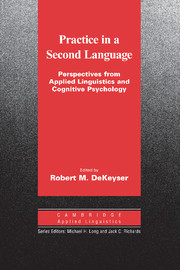Introduction: Situating the concept of practice
Published online by Cambridge University Press: 27 January 2010
Summary
Practice gets a raw deal in the field of applied linguistics. Most lay-people simply assume that practice is a necessary condition for language learning without giving the concept much further thought, but many applied linguists eschew the term practice. For some, the word conjures up images of mind-numbing drills in the sweatshops of foreign language learning, while for others it means fun and games to appease students on Friday afternoons. Practice is by no means a dirty word in other domains of human endeavor, however. Parents dutifully take their kids to soccer practice, and professional athletes dutifully show up for team practice, sometimes even with recent injuries. Parents make their kids practice their piano skills at home, and the world's most famous performers of classical music often practice for many hours a day, even if it makes their fingers hurt. If even idolized, spoiled, and highly paid celebrities are willing to put up with practice, why not language learners, teachers, or researchers? The concept of second language practice remains remarkably unexamined from a theoretical point of view. Misgivings and misunderstandings about practice abound and are often rooted in even deeper misunderstandings about what it is that language learners are supposed to learn. In this introductory chapter, I will try to provide some conceptual and terminological clarification in preparation for the rest of the book.
- Type
- Chapter
- Information
- Practice in a Second LanguagePerspectives from Applied Linguistics and Cognitive Psychology, pp. 1 - 18Publisher: Cambridge University PressPrint publication year: 2007
References
- 44
- Cited by

